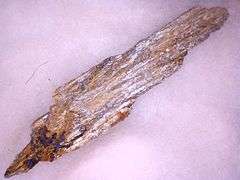Bismoclite
| Bismoclite | |
|---|---|
|
Yellow-orange bismoclite on bismuthinite from the Alto do Giz pegmatite, Equador, Rio Grande do Norte, NE-region, Brazil. Approximate size: 20 x 6 x 2 mm. | |
| General | |
| Category | Halide mineral |
| Formula (repeating unit) | BiOCl |
| Strunz classification | 3.DC.25 |
| Dana classification | 10.2.1.2 |
| Crystal system | Tetragonal |
| Crystal class |
Ditetragonal dipyramidal (4/mmm) H-M symbol: (4/m 2/m 2/m) |
| Space group | P4/nmm |
| Unit cell |
a = 3.887 Å, c = 7.354 Å; Z = 2 |
| Identification | |
| Color | Cream-white, greyish, yellowish brown |
| Crystal habit | Platey to thin rectangular crystals, fibrous to columnar, massive |
| Cleavage | {001} perfect |
| Tenacity | Elastic |
| Mohs scale hardness | 2-2.5 |
| Luster | Greasy, silky, pearly, dull, earthy |
| Streak | White |
| Diaphaneity | Transparent to translucent |
| Specific gravity | 7.36 (measured), 7.784 (calculated) |
| Optical properties | Uniaxial (-) |
| Refractive index | nω = 2.150 nε = 1.910 |
| Birefringence | δ = 0.240 |
| References | [1][2][3][4] |
Bismoclite is a bismuth oxohalide mineral with formula BiOCl. The name was derived from its chemical constituents. It is a secondary bismuth mineral first thought to be composed of bismuthyl ions (BiO+) and chloride anions, however, the existence of the diatomic bismuthyl ion is doubtful.[5] It is a member of the matlockite group.
It was first described in 1935 from alluvium near bismuth-bearing pegmatites in South Africa.[2] It has been found in association with granite pegmatite and in greisen. Associated minerals include bismutite, mica, jarosite, alunite, cerussite, atacamite, connellite. Occurrences include the type locality at Jackals Water, SW of Prieska, South Africa; Bygoo, Australia; the Tintic district in the East Tintic Mountains of Utah; and from Dalbeattie, Scotland.[3]
Crystal structure
The crystal structure of bismoclite was found to be composed of linked decahedrons, specifically a square antiprism.[6] These decahedrons consist of 2 squares with sides of 3.487 Å (O-O-O-O and Cl-Cl-Cl-Cl) connected by 8 isosceles triangles (O-Cl-O and Cl-O-Cl), with a bismuth atom at the centre.[6] The Bi-O distances and Bi-Cl distances are 2.316 Å and 3.059 Å, respectively. The O-Cl distances in the triangles are 3.249 Å. The decahedrons are linked to each other through shared O-Cl sides.[6]
References
- ↑ Mineralienatlas
- 1 2 Bismoclite on Mindat.org
- 1 2 Bismoclite in the Handbook of Mineralogy
- ↑ Bismoclite data on Webmineral
- ↑ Nils., Wiberg,; 1859-, Holleman, A. F. (Arnold Frederick), (2001-01-01). Inorganic chemistry. Academic Press. ISBN 0123526515. OCLC 48056955.
- 1 2 3 Keramidas, Κ. G.; Voutsas, G. P.; Rentzeperis, P. I. (1993-08-01). "The crystal structure of BiOCl". Zeitschrift für Kristallographie - Crystalline Materials. 205 (1-2). ISSN 2196-7105. doi:10.1524/zkri.1993.205.12.35.
